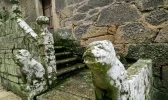- Time of past OR future Camino
- Except the Francés
The southern version of the Sanabrés is strangely neglected. I like the northern one very much, and think the section on the high ground round the Venta de Teresa after A Gudiña has some of the loveliest few hours of any camino I know.
But I don't see why so few people head for Verín, which is a fine town with good food looked down on by the archetype of a fierce border castle. Apparently I was about the 100th person this year to stay in the excellent huge xunta albergue of Villaderei 20-odd pleasant km further on, which is silly.
Allaríz is another handsome friendly town. Quite nearby, and only about 500m off the official camino into Ourense, is the little village of Santa Mariña de Augas Santas, almost but not quite unpopulated. It's on a ridge looking down on the Miño valley and Ourense - when I was there this Monday the valley below was partly full of clouds, but Santa Mariña was in bright sunshine, very lovely.
Anyway, Santa Mariña was a chaste young Christian about the time the Emperor Hadrian was building his wall near where I live. She attracted the attention of the local Roman prefect, Olibrio, from nearby Armea, who had evil intentions. She rejected his advances, which annoyed him to the extent that he had her whipped and tortured, without changing her mind. He then got fed up and ordered her to be burned in a nearby oven. St Peter personally put out the fire, and she washed off her ashes in the nearest fuente, now the Auguas Negras as a result. Olibrio, by now presumably very pissed off, ordered that her head should be cut off, which it was - St Peter must have moved on by then. Her head bounced three times, and in each place a holy fountain appeared, the current Augas Santas, just next to the Romanesque church in her honour, complete with rose windows. Nearby you can see the unfinished basilica of the Ascensión, built over the forno da Santa, which she was incompletely burnt in. And on the Roman road leading back on to the camino you can see part of the well-excavated remains of the town of Armea.
The village also has the handsome old summer palace of the local Bishop, guarded by a pair of very fine lions, who remind you of the Iraqi poet al Mutannabi's line "when the lion shows his teeth, do not imagine he is smiling at you."
An easy detour, and well worth it, I'd say. And very tasty cool (holy) water.

But I don't see why so few people head for Verín, which is a fine town with good food looked down on by the archetype of a fierce border castle. Apparently I was about the 100th person this year to stay in the excellent huge xunta albergue of Villaderei 20-odd pleasant km further on, which is silly.
Allaríz is another handsome friendly town. Quite nearby, and only about 500m off the official camino into Ourense, is the little village of Santa Mariña de Augas Santas, almost but not quite unpopulated. It's on a ridge looking down on the Miño valley and Ourense - when I was there this Monday the valley below was partly full of clouds, but Santa Mariña was in bright sunshine, very lovely.
Anyway, Santa Mariña was a chaste young Christian about the time the Emperor Hadrian was building his wall near where I live. She attracted the attention of the local Roman prefect, Olibrio, from nearby Armea, who had evil intentions. She rejected his advances, which annoyed him to the extent that he had her whipped and tortured, without changing her mind. He then got fed up and ordered her to be burned in a nearby oven. St Peter personally put out the fire, and she washed off her ashes in the nearest fuente, now the Auguas Negras as a result. Olibrio, by now presumably very pissed off, ordered that her head should be cut off, which it was - St Peter must have moved on by then. Her head bounced three times, and in each place a holy fountain appeared, the current Augas Santas, just next to the Romanesque church in her honour, complete with rose windows. Nearby you can see the unfinished basilica of the Ascensión, built over the forno da Santa, which she was incompletely burnt in. And on the Roman road leading back on to the camino you can see part of the well-excavated remains of the town of Armea.
The village also has the handsome old summer palace of the local Bishop, guarded by a pair of very fine lions, who remind you of the Iraqi poet al Mutannabi's line "when the lion shows his teeth, do not imagine he is smiling at you."
An easy detour, and well worth it, I'd say. And very tasty cool (holy) water.















